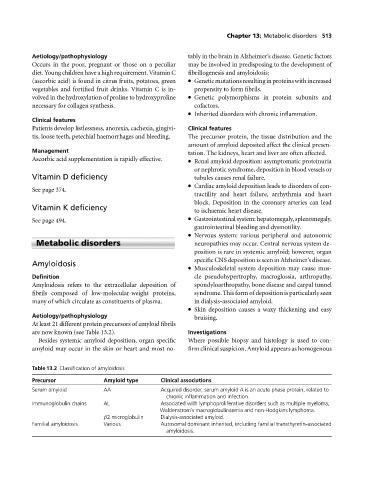Page 517 - Medicine and Surgery
P. 517
P1: KOA
BLUK007-13 BLUK007-Kendall May 13, 2005 16:24 Char Count= 0
Chapter 13: Metabolic disorders 513
Aetiology/pathophysiology tably in the brain in Alzheimer’s disease. Genetic factors
Occurs in the poor, pregnant or those on a peculiar may be involved in predisposing to the development of
diet. Young children have a high requirement. Vitamin C fibrillogenesis and amyloidosis:
(ascorbic acid) is found in citrus fruits, potatoes, green Geneticmutationsresultinginproteinswithincreased
vegetables and fortified fruit drinks. Vitamin C is in- propensity to form fibrils.
volved in the hydroxylation of proline to hydroxyproline Genetic polymorphisms in protein subunits and
necessary for collagen synthesis. cofactors.
Inherited disorders with chronic inflammation.
Clinical features
Patients develop listlessness, anorexia, cachexia, gingivi- Clinical features
tis, loose teeth, petechial haemorrhages and bleeding. The precursor protein, the tissue distribution and the
amount of amyloid deposited affect the clinical presen-
Management tation. The kidneys, heart and liver are often affected.
Ascorbic acid supplementation is rapidly effective. Renal amyloid deposition: asymptomatic proteinuria
or nephrotic syndrome, deposition in blood vessels or
Vitamin D deficiency tubules causes renal failure.
Cardiac amyloid deposition leads to disorders of con-
See page 374.
tractility and heart failure, arrhythmia and heart
block. Deposition in the coronary arteries can lead
Vitamin K deficiency
to ischaemic heart disease.
See page 494. Gastrointestinal system: hepatomegaly, splenomegaly,
gastrointestinal bleeding and dysmotility.
Nervous system: various peripheral and autonomic
Metabolic disorders neuropathies may occur. Central nervous system de-
position is rare in systemic amyloid; however, organ
specific CNS deposition is seen in Alzheimer’s disease.
Amyloidosis
Musculoskeletal system deposition may cause mus-
Definition cle pseudohypertrophy, macroglossia, arthropathy,
Amyloidosis refers to the extracellular deposition of spondyloarthropathy, bone disease and carpal tunnel
fibrils composed of low-molecular-weight proteins, syndrome. This form of deposition is particularly seen
many of which circulate as constituents of plasma. in dialysis-associated amyloid.
Skin deposition causes a waxy thickening and easy
Aetiology/pathophysiology bruising.
At least 21 different protein precursors of amyloid fibrils
are now known (see Table 13.2). Investigations
Besides systemic amyloid deposition, organ specific Where possible biopsy and histology is used to con-
amyloid may occur in the skin or heart and most no- firm clinical suspicion. Amyloid appears as homogenous
Table 13.2 Classification of amyloidosis
Precursor Amyloid type Clinical associations
Serum amyloid AA Acquired disorder, serum amyloid A is an acute phase protein, related to
chronic inflammation and infection.
Immunoglobulin chains AL Associated with lymphoproliferative disorders such as multiple myeloma,
Waldenstrom’s macroglobulinaemia and non-Hodgkins lymphoma.
β2 microglobulin Dialysis-associated amyloid.
Familial amyloidosis Various Autosomal dominant inherited, including familial transthyretin-associated
amyloidosis.

